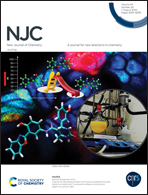Significant promotion effects of Ag oxide towards Pd catalysis for ethanol and methanol oxidation reactions†
Abstract
A series of PdmAg/C electrocatalysts (m being the atomic Pd/Ag ratio, m = 0.05, 0.1, 0.5, 1.0) for both ethanol and methanol oxidation reactions (EOR and MOR) are prepared via a facile co-reduction method. The morphologies and crystal structures are characterized by transmission electron microscopy techniques (TEM) and X-ray diffraction (XRD). Cyclic voltammetry (CV) and chronoamperometry (CA) techniques are applied to explore the catalytic performance of the PdmAg/C electrocatalysts for EOR and MOR in alkali medium. Our findings show that the catalytic performance of the PdmAg/C electrocatalysts rests with m and Pd0.5Ag/C has the highest activity among the PdmAg/C electrocatalysts. Furthermore, the activities of the PdmAg/C electrocatalysts are associated with the potential scope of CV curves. When Pd0.5Ag/C is tested in a relatively wide potential scope (−1.0 to 0.5 V), the current density of EOR is ca. 9.39 times higher than that tested in the narrow potential scope (−1.0 to 0.1 V). The improvement is ascribed to the promotion effects of Ag oxide formed at relatively high potential, that is, the synergistic effects between Ag oxide and Pd contribute to the improvement in the catalytic properties of Pd.



 Please wait while we load your content...
Please wait while we load your content...